Companies are no longer telling their customers what they think they want to hear. Instead, successful organizations are focusing on delivering tailored experiences, unique workflows, and the right amount of information at the right time.
All of this must happen while also maintaining efficiency and optimal operations within the company.
A big part of this are forms, which are used to create user centric, intuitive page layouts that display the right information at the right time.
For this article’s purposes, we will be focusing on dynamic forms. Which are also called smart fillable forms or smart forms.
We’ll also cover:
-
-
- What are smart fillable forms?
- Smart Forms: More than fillable PDF forms
- What are fillable forms used for?
- Using software to create and manage forms information
- Why you may need more than just free online fillable forms
- The top 10 best software to create forms and smart fillable forms
-
So let’s get started by answering the most asked questions about fillable forms.
What are smart fillable forms?
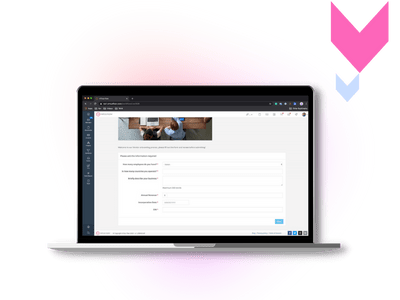
Smart fillable forms are smart or dynamic (interactive) forms. This means that these forms may adjust or change according to the information previously entered by the user.
These are commonly used in a wide range of landing pages, surveys, quizzes, applications, and much more.
The goal for these forms can be to gather data, get customer feedback, accept payments, or any other task in which a user needs to fill in the desired fields.
But there is so much more you can do with them.
We’ll get into that shortly.
It’s important to note that you can classify fillable forms into two fields: smart (dynamic) and static.
For example: if you are filling out a dynamic loan application form, the fields may change depending on the amount of money you are requesting. Since different levels of risk require different procedures and verifications.
Therefore, the bank may require you to provide additional information.
While the classic static application form will remain invariable and several back and forth steps may be needed later.
Their use goes beyond data collection. We get into a more detailed explanation below.
A common example for static forms are PDF fillable forms, which users can fill out from any device.
Smart Forms: More than PDF fillable forms
With PDF forms, you run the risk of the user leaving fields blank, missing signatures, calculating numbers incorrectly, not saving the data correctly, and a plethora of data entry issues.
Unlike PDF forms, with smart forms data is managed as data objects. This allows the company to store, distribute, retrieve and overall manage data individually.
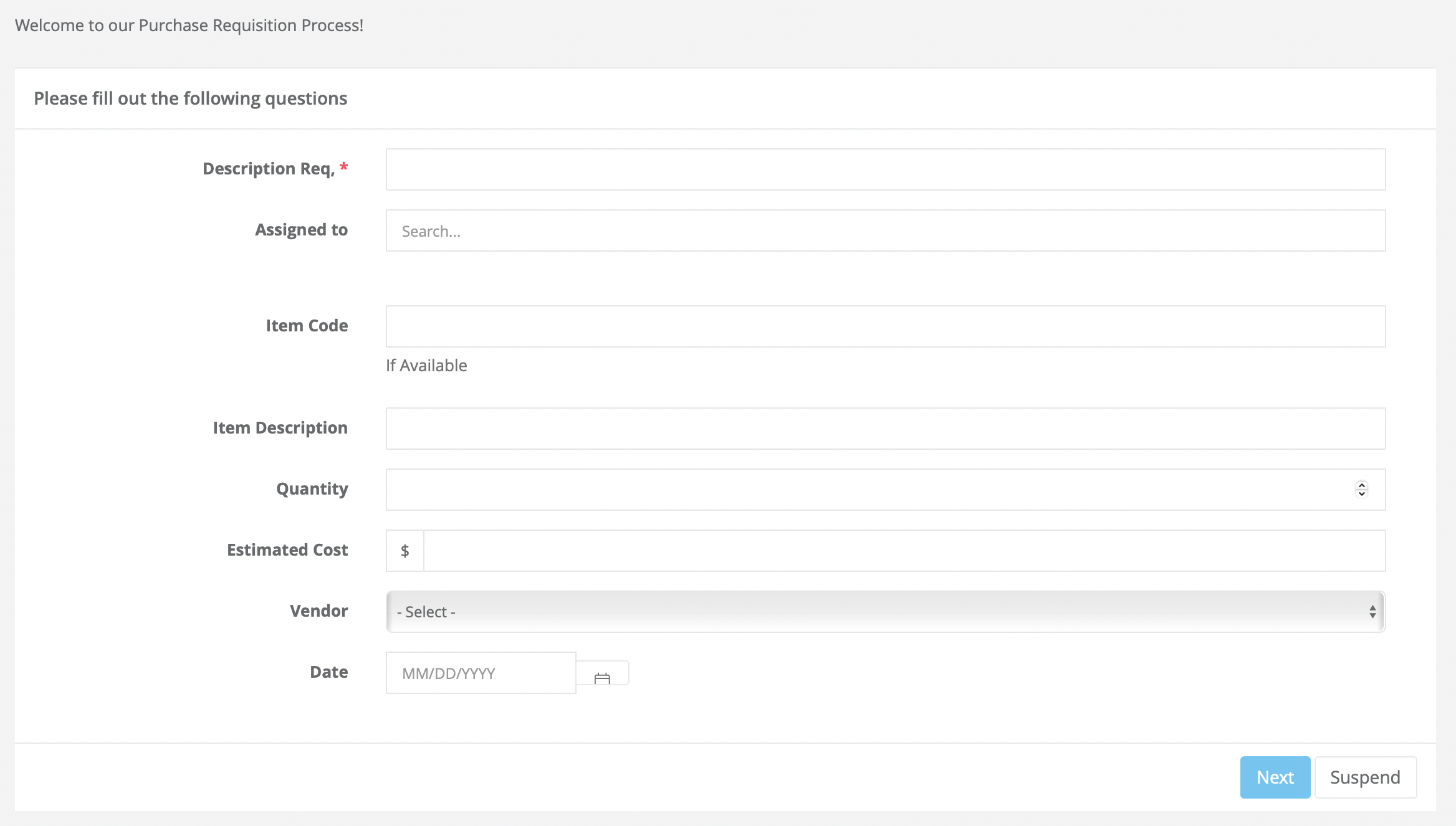
This gives users the possibility to:
-
-
- generate documents automatically from data entered,
- attach documents to support information entered,
- create and automate workflows or processes,
- embed automatic calculations,
- pull/trigger data from/to third party apps,
- distribute data automatically, etc.
-
One of the main benefits of smart forms is that they let you pull data directly from the form and push to third party applications and your database.
This makes distribution much easier, as it saves you a huge amount of time, reduces human error and the need for manual work.
Example: how to use dynamic forms to automate document generation.
Create smart forms in minutes!
What are fillable forms used for?
Because of their dynamic nature, fillable forms guide the user and change according to information previously entered.
Companies are using form builder software to create any type of forms and automate processes such as these.
Onboarding Process and HR
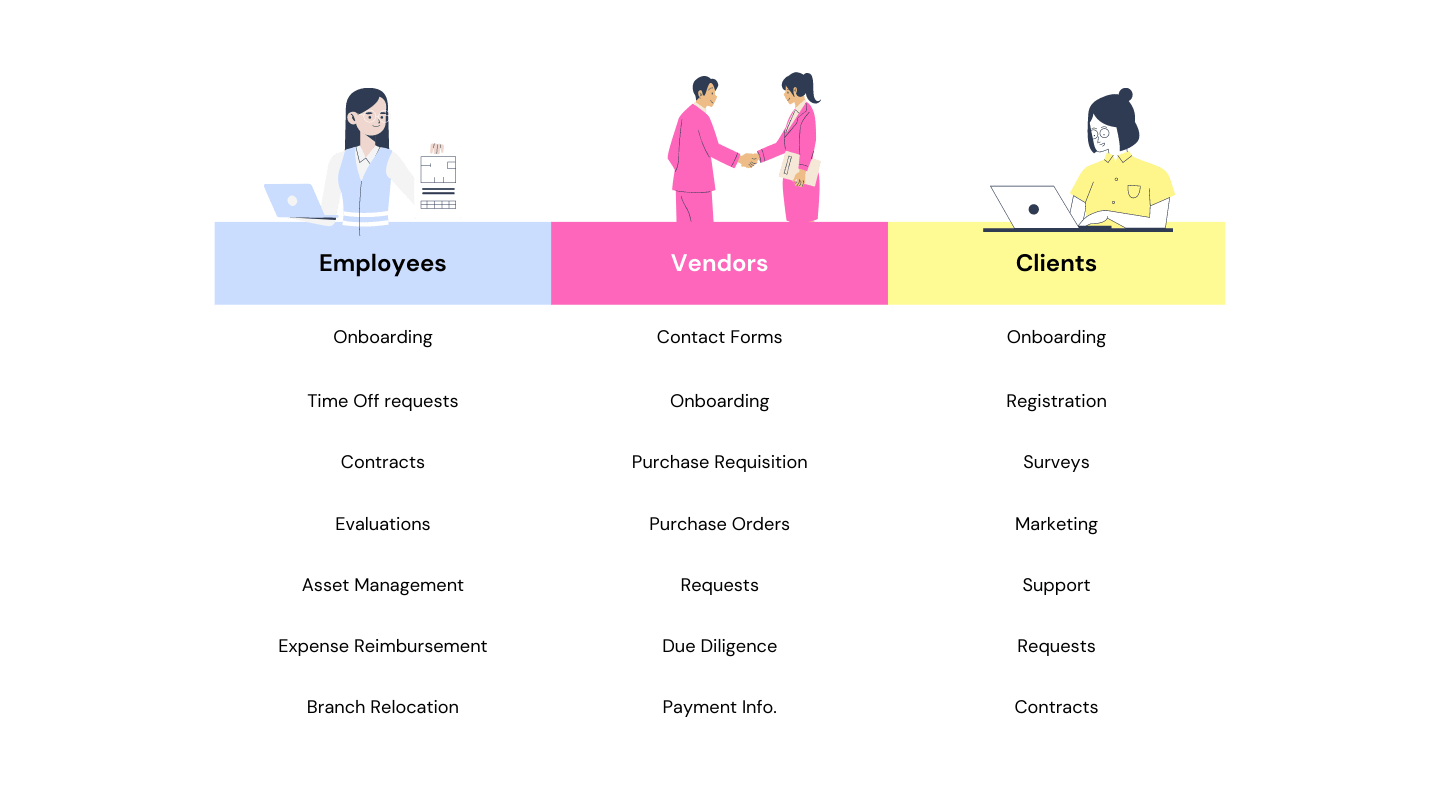
Employees: You can use smart forms for employee onboarding, time off requests, contract generation, evaluations, branch relocation, asset management, expense reimbursement requests, etc.
Vendors: Gather key vendor information through contact forms, vendor onboarding; new purchase requests, requests and approvals, due diligence, etc Watch this video about digital vendor onboarding for more information.
Clients: Forms are valuable for client onboarding, registration forms, client feedback, marketing efforts, contract creation and any other task that requires input from your customers.
RELATED CONTENT:
Requests and Claims
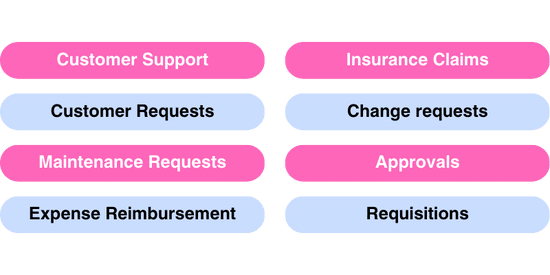
Customer support: When you use ready-to-use, custom form templates, your customers can easily use them to reach you in a more timely manner.
Customer requests: Your customers can also put in requests and fill in all the necessary form fields you require. Even out of operative hours. (these forms can be easily embed in your website for easier access)
→ Explore Virtus Flow Ticketing System
Insurance claims: You can eliminate the need for an initial phone call and simply have your policy holders fill out a form to submit a claim. It can be initiated by the insured filling the claim directly or by your team if you desire it that way.
Employee PTO requests: Smart forms also serve companies internally, as they can use it for PTO requests and other employee needs.
If you have a PTO policy in place you can give automatic approvals (you can apply logic and conditions to your forms that allow you to give automatic approvals or not, if certain criteria is met)
→ TEMPLATE: PTO Request Template
Maintenance requests: The facility management department can schedule and automate recurrent or non ordinary maintenance and send the request to vendors automatically.
Expense reimbursement requests: Accounting departments find smart forms valuable for expense reimbursement requests as users can fill in all the needed fields to provide key information.
→ TEMPLATE: Expense Reimbursement Template
Budget approval: Also this process benefits from automated approvals when the amount, reason, etc meets certain criteria.
(all conditions and logic can be determined by you)
Employee requisitions: Pre-built forms make the process for job requisitions much more straightforward.
Learn to automate your processes with Smart Forms!
Applications

Loan application: This process requires a lot of information, so you can’t simply rely on Google forms or another out-of-the-box platform.
Instead, a customizable template will let you add in all the required fields for your prospects to apply for loans in minutes. Learn more about automation for digital lending here.
⇔ Explore Virtus Flow Digital Lending solution
Credit application: Much like loan applications, credit applications require certain data that must be provided safely, while also making it easier for the applicant to navigate.
Job application: With smart forms, applicants can submit all the necessary data and make it easier for your recruiters to review.
Benefits application: Smart forms make benefits application much easier as you can ask applicants to only give you the information you need.
Using a form creator to create and manage data
The main goal for using dynamic fillable forms is to better manage information contained in important documents.
Even though the visual and digital aspect of a form can be important, smart forms offer much more than a way to show data visually.
They also help organizations become more efficient and find smarter ways to manage the data contained in incoming forms.
If you’re still using PDF forms, or static forms you’re stuck having to open each form and search for information.
With dynamic forms, however, you can rely on smarter processes that pull and organize the data for you. After which you can pull specific data in seconds.
The outcome is better, clearer, real time view of clients, employees, vendors, prospects, applications, requests, claims and overall work.
Why you need more than free online fillable forms
A free online form builder software may be good for very small businesses (10 people max) looking to digitize tasks like calendar booking, survey creation, and basic data input.
However, for companies looking to digitize processes end-to-end, minimize data entry, elevate data integrity, improve visibility across boards, free online forms simply don’t do enough.
Key reasons to stay away from free online or static forms
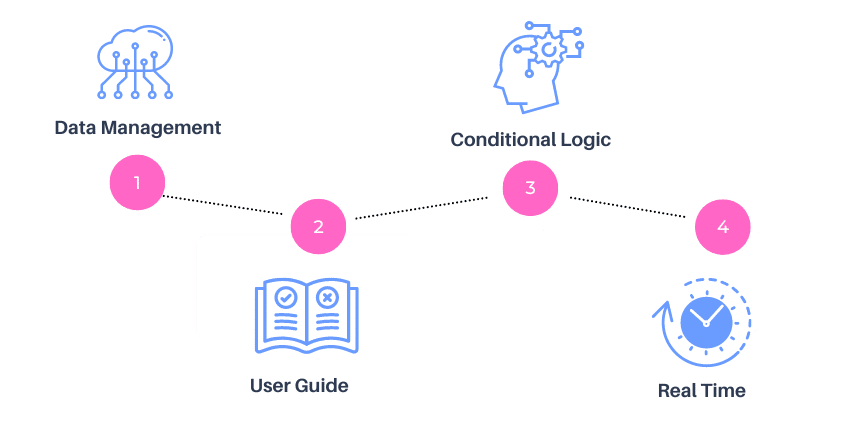
1- Free web forms may solve the problem of gathering the data from users. But do not solve the problem of how that data is managed internally. This can result in extra manual work, more human error and inaccurate data.
2- Dynamic forms allow you to pre-populate fields, add required fields, and use tools like drop-down menus to make the process much easier. It helps guide the user in the process. Be it internal or external users.
3- You can include conditional logic and mandatory fields on your smart forms. This avoids missing information since the user can’t move to the next field without filling out the items you need.
4- Once the form is filled, with smart forms you can access the data in real time, without having to wait for the user to email it to you. Free online tools do not allow you to manage information from a centralized dashboard.
The 10 Best Software to Create Forms
Now that you know the reasons why smart forms are the best way to capture and manage essential data, and even automate full processes, let’s explore the best software to create forms.
1- Virtus Flow
It’s an enterprise level No-Code Digital Process Automation platform with which users can automate processes completely code free. We do this through dynamic smart forms and a very powerful and flexible workflow engine.
It is more than just a software to create forms.
It offers digital workflow and document automation features, the possibility to add eSignatures to documents generated through forms, ticket and project management, and out-of-the-box apps.
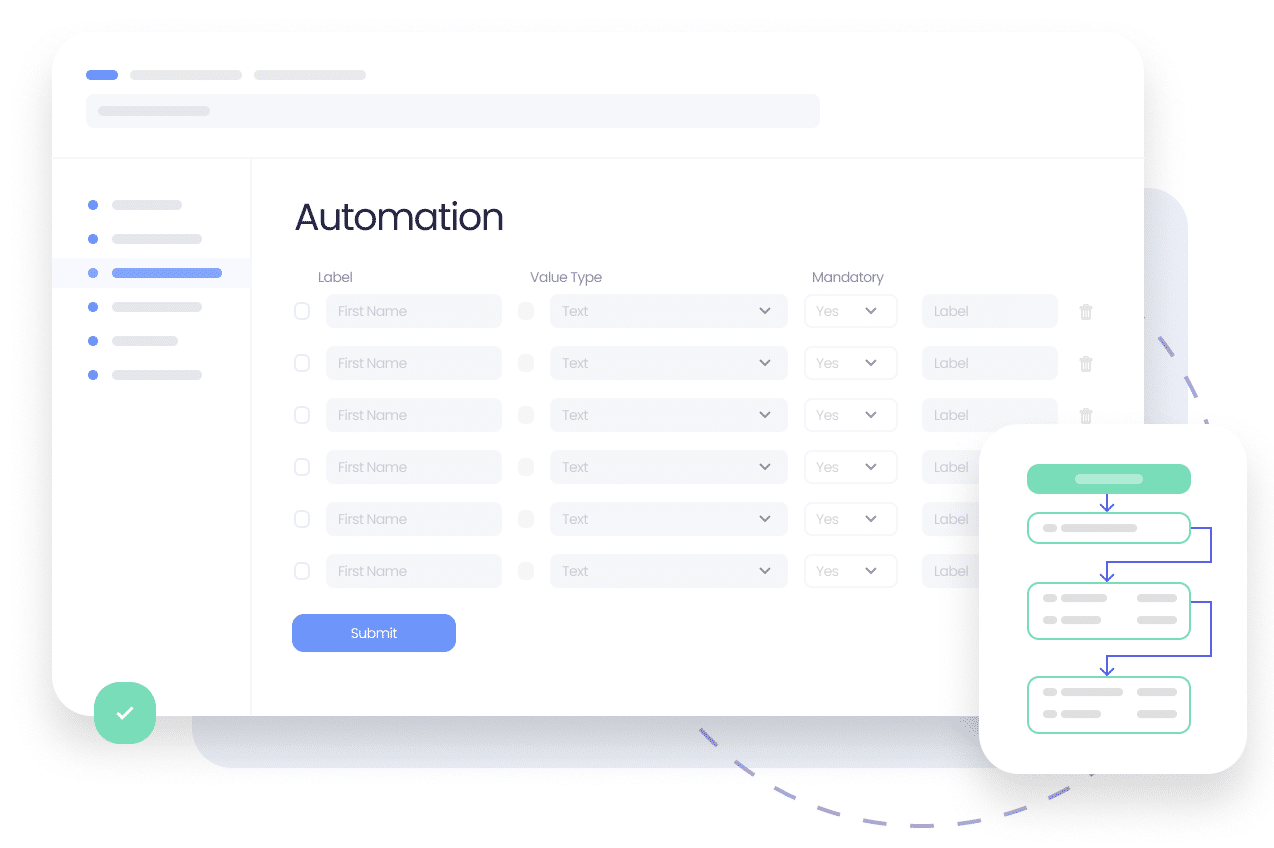
Features of Virtus Flow dynamic form building software
-
- Create and add the logic and conditions that apply to your forms/processes (not a one fits all solution)
- Easy to use drag and drop form builder
- Go from design to deployment in as little as 10 minutes
- Easy & secure third party app integration
- Complete, user friendly and customizable work management dashboard
- Customize your forms to create same look and feel as your company
- Embed in your website in seconds
- Automatically calculated fields
- Potent no code automation engine that lets you automate even the most intricate processes
- Powerful Data Management Tools
How to create forms with Virtus Flow
Choose a process and we will automate it for FREE!
2- Cognito Forms
This powerful form builder lets you collect data, accept payments, and work more efficiently.
Important features:
- No-code form builder: Drag and drop fields, property customization, etc.
- Conditional logic that allows to build personalized and adaptive forms
- Data management tools: collect, store and analyze form submissions.
3- Zoho Forms
It’s an online form builder that offers a variety of features to help you create and manage forms.
Main features:
- Drag-and-Drop form Builder: It offers a good range of form fields, such as text fields, checkboxes, dropdown menus, ratings, etc.
- Conditional Logic: Show or hide form fields, sections, or entire pages based on user responses.
- Integrations: It integrates with other Zoho applications and third-party services such as Zoho CRM, Zoho Campaigns, Google Sheets, and Zapier.
4- Jotform
Ideal for small and medium size businesses with basic to medium difficulty form creation needs.
Features include:
- Versatile form builder: Drag-and-drop interface that allows you to create customized forms. It offers a wide selection of form fields, including text fields, checkboxes, radio buttons, dropdown menus, file uploads, etc.
- Templates & themes: It has a library of pre-designed form templates and themes. These templates include event registrations, surveys, job applications, contact forms, etc.
- Integrations & automation: It offers integrations with tools like Google Drive, Dropbox, PayPal, Mailchimp, Salesforce, and more.
5- Paperform
It’s an online low code form builder that focuses on creating beautiful, interactive forms and landing pages.
Features include:
- Customization and branding: It allows users to create forms and landing pages that align with their brand identity by selecting colors, fonts, and backgrounds. You can add custom CSS and JavaScript to further customize the form’s look and behavior.
- Versatile question and field types: Users can choose from options such as multiple-choice questions, text fields, checkboxes, dropdown menus, file uploads, and more.
- Conditional Logic and Automation: Users can create dynamic and interactive forms that adapt based on respondents’ answers.
6- Formstack
It’s an online form builder and data management platform that offers a range of features for creating, managing, and automating forms and workflows.
Main features are:
- Drag and drop form builder: It offers a wide range of form field options, including text fields, checkboxes, dropdown menus, file uploads, electronic signatures, and more. Users can customize the form layout, apply conditional logic, and implement advanced features like calculations.
- Data Management: Capture, store, and analyze form submissions. It offers features like data encryption, HIPAA compliance, and data retention policies to ensure data security and compliance.
- Workflow Automation: Users can create custom workflows using conditional logic, approval processes, and notifications.
7- GoFormz
It’s a mobile forms and data capture platform that enables businesses to digitize their paper forms and streamline data collection processes.
Main features include:
- Mobile-First Solution: GoFormz is designed with a mobile-first approach, allowing users to create and complete forms on smartphones and tablets.
- Automation: It offers powerful features such as automatic calculations, conditional logic, and integration with other systems and databases.
- Data management: Advanced search, reporting, and analytics, enabling users to gain insights from the collected data
8- Typeform
It is known for its interactive and engaging user experience.
Features include:
- Conversational and interactive design: Typeform focuses on creating conversational and interactive forms that feel more like conversations rather than traditional forms. It uses a one-question-per-screen format, guiding respondents through a step-by-step process.
- Conditional logic & personalization: Customize the form experience based on respondents’ previous answers. Users can create dynamic paths in the form, showing or hiding questions or sections based on specific conditions.
- Data collection & analysis: It captures and stores form responses in a structured manner, allowing users to access and export the data easily. View response analytics, create custom reports, and generate visualizations to gain insights from the collected data.
9- FormAssembly
A form builder and data collection platform that offers a range of features for creating secure and customizable forms.
Features include:
- Customization: It allows users to create forms that match their branding and specific requirements. Advanced features like conditional logic, calculations, and form rules enable dynamic and personalized form experiences.
- Advanced security & compliance: It offers secure form hosting with data encryption, SSL/TLS support, and compliance with industry standards such as HIPAA, GDPR, and CCPA. FormAssembly also provides advanced security settings like field encryption, password protection, and CAPTCHA to prevent unauthorized access and ensure data privacy.
- Seamless data integration: Connect form submissions with various systems and applications. It offers pre-built integrations with popular platforms like Salesforce, Google Sheets, Microsoft Dynamics, and more.
10- Nintex
It is an enterprise level platform for process automation, workflow management, and document generation.
Main features include:
- Low code Process Automation: Create and manage complex workflows and automate repetitive tasks without the need for extensive coding knowledge. Visual designer interface with drag-and-drop functionalities.
- Integrations: Nintex offers seamless integration capabilities with various systems and applications, including CRM platforms, content management systems, and cloud storage services.
- Document Generation: It allows users to create dynamic, personalized documents based on form data or workflow inputs.




